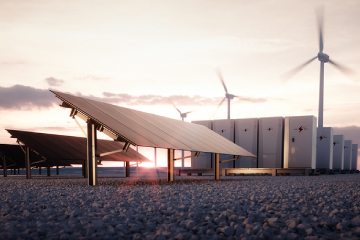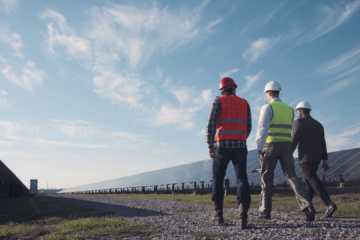- About UsAbout UsWe’re committed to providing future generations with the means to power their lives in the most economic, environmental and socially responsible ways possible.
- What We DoWhat We DoWe are a market-leading, independent power producer and service provider, delivering: wind (onshore and offshore), solar photovoltaic, storage, and electrical vehicle charging.
- Landowners
- Suppliers
- Projects
- Careers
- News
- Contact
Delivering Success Through Innovative Approaches to PPA Risk Sharing

By Erik Ejups, Associate Director, Origination and Power Marketing
There was a time when the challenges of contracting renewable energy stemmed from its novelty. The technologies were unproven, the risks were poorly understood, and buyers and sellers made up the rules as they went along.
Today, many of those uncertainties have been eliminated. Wind and solar are proven technologies, and owners, investors and financial institutions are confident in the ability of renewables to perform within expectations. However, new challenges to project development, construction and operations have emerged. Some are longstanding issues, like bottlenecked interconnection queues and the threat of new laws and regulations that could negatively impact renewables. More recently, the pandemic has introduced new constraints: supply chain delays, transportation challenges, commodity pricing increases and workforce shortages. Against this backdrop, demand for renewable energy has outpaced the supply of viable projects. This creates a conundrum for organizations that want to reduce their carbon footprint and creates a need for all stakeholders to work toward offtake agreements that are financeable and nimble enough to survive today’s heightened uncertainty.
EDF Renewables has been active in North America for more than 35 years. We have developed over 24 gigawatts of renewable generation, making us one of the largest companies in the space. Backed by one of the largest utilities in the world, we balance sheet finance the development and construction of projects and with few exceptions retain majority ownership throughout the asset’s life. EDFR’s position as a long-term asset owner and operator with a large generating fleet means we’ve developed strategies to mitigate many of the uncertainties inherent in the process. We have an approach focused on the long-term sustainability of our asset base and business relationships.
Thus, when faced with the market challenges that have developed over the past two years (and show no signs of abating in the immediate future), we have created innovative contract structures to get projects across the finish line. Working closely with our customers, we have successfully negotiated and executed power purchase agreements (PPAs) based on risk-sharing structures that protect both parties against the vagaries of the market. These structures include PPA prices that adjust based on market conditions, permissible extensions to targeted commercial operation dates (COD), regulatory risk sharing and basis risk sharing.
PPA Price Adjustment: The PPA price adjustment is a mechanism that allows for the PPA price to float in response to key capital costs, such as manufacturing and transportation of project equipment as well as the full engineering, procurement, and construction. Shortly before project financing is finalized, the PPA price is recalculated based on final costs verified by an independent accountant, or changes in a commodity index since the PPA was executed. If the cost of the project increases relative to a base case, the PPA price increases by a corresponding pre-agreed rate. Correspondingly, if costs decrease, the PPA price is reduced – so both EDFR and the customer share the potential risk and benefits of changes in the market. The contract includes off-ramps for both parties if the PPA price adjustment is beyond an upper bound and neither wishes to proceed.
COD Extensions: The Commercial Operation Date (COD) extension mechanism addresses multiple risks including import delays caused by US Customs and Border Protection. It is also used for interconnecting utility and development milestone delays. The COD can be extended without penalty in the event of a slowdown resulting from any of these issues.
Regulatory Risk: Regulatory risk sharing is another key feature of these contracts. If a potential change in law is not resolved before the final investment decision has been made, the seller can delay commercial operation – or, if the after an initial extension there is still no resolution, terminate the PPA. After the issuance of the final investment decision, the seller covers the first tranche of cost attributable to adverse regulatory change and the buyer covers the next tranche of cost. If costs attributable to adverse regulatory changes exceed these combined levels, the buyer can elect to proceed and cover the excess cost, or the seller can terminate the PPA.
Basis Risk: Basis is the difference between the price earned by the seller for selling energy at the project’s node, and the price paid by the seller, under the PPA, at the trading hub. This risk, worn almost exclusively by sellers in corporate PPAs, has become unsustainable. Developers are pushing back and seeking partners willing to share in the risks of the project during the tenor of the PPA. EDFR has worked with offtakers to limit the total basis cost that can be borne by the seller in any contract year. Without this risk protection, projects can become cashflow negative and risk failure. When the total cost is exceeded, the PPA settles at the project’s node which absolves seller of basis risk for the remainder of the contract year.
EDF Renewables is dedicated to long-term growth and focused on solving for risks, rather than chasing the highest potential returns and unrealistic assumptions that won’t pass scrutiny in project financing. By addressing the chief concerns of both parties and equitably sharing risk, these innovative PPA structures demonstrate it’s possible to deliver successful outcomes even under uncertain and challenging conditions. In today’s market, working with an established, experienced and well-capitalized developer can mean the difference between achieving commercial operation or having a large investment of time, money and effort come to naught.
Post a Comment Cancel reply
- © 2025 EDF Renewables North America
- Privacy Policy
- AB 1305 Disclosure
- TCFD Report



Comments (1)
Very well written and informative article Erik.